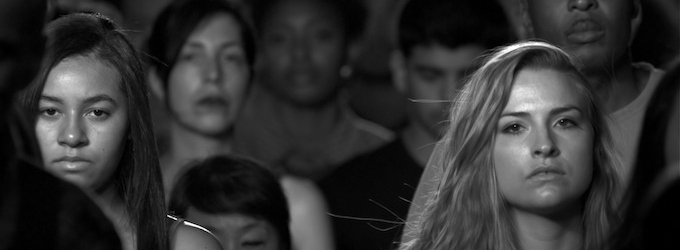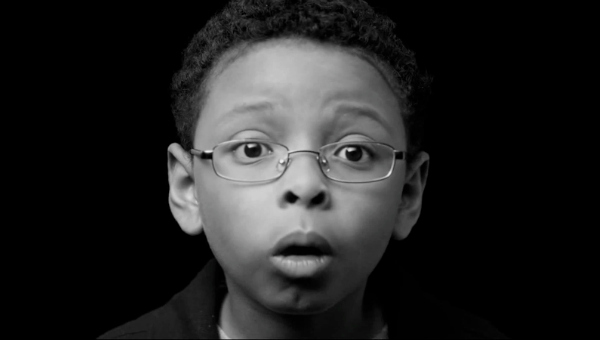 Godfrey Reggio’s body of work so far constitutes a trilogy of films that took 20 years to complete: KOYAANIQATSI, POWAQQATSI and NAQOYQATSI. Such is the impact of the director’s previous work – sparse though it might be – that viewers are inevitably going to come to his latest film with a certain expectation as to the subject matter and nature of the film.
Godfrey Reggio’s body of work so far constitutes a trilogy of films that took 20 years to complete: KOYAANIQATSI, POWAQQATSI and NAQOYQATSI. Such is the impact of the director’s previous work – sparse though it might be – that viewers are inevitably going to come to his latest film with a certain expectation as to the subject matter and nature of the film.
Whether those expectations are met by VISITORS will depend on the individual viewer’s interpretation, and their willingness to respond to the images and the content; but it’s clear at least that Reggio is striving to expand his cinematic language, in order to move a stage beyond the Qatsi trilogy.
“We have art so that we may not perish by the truth” (Friedrich Nietzsche)
Some of the imagery used in VISITORS does admittedly look familiar. There’s a considerable amount of portraiture: faces look directly at the camera, buildings are filmed like monuments and clouds flow like rivers in timelapse photography. Jarring juxtapositions between the natural and the man-made world are presented from an unfamiliar perspective, in slow-motion. All of this is set to the rolling arpeggios of the obligatory Philip Glass score, with no natural sound or dialogue. But the context for these images and music is different this time, and it’s difficult to draw any single overt message from the film.
In KOYAANIQATSI (1982), the contrast between the natural world and the man-made – highlighted by the innovative and influential cinematography of Ron Fricke (BARAKA) – was used more clearly to illustrate Reggio’s concerns with life out of balance with the natural world; with a principal focus on North America. POWAQQATSI (1988) extended that view to show the devastating consequences of this modern lifestyle on Third World countries. By the time Reggio came to complete the trilogy fourteen years later with NAQOYQATSI (2002), the world of the first two films was barely recognisable due to the advances in technology, and the threats for civilisation prophesied by the Native American Hopi tribe that form the basis of the concept for those films (and their titles) is in danger of being lost in the babble of modern communications.
VISITORS, while not directly concerned with the prophesies of the Hopi, does seem to be connected to the QATSI trilogy in as far as it represents an attempt by the filmmakers to go further and consider the impact of technology on the individual, our relationship with it, and how it forms the view we have of the world. The filmmakers (Reggio gives equal credit to Glass and associate director Jon Kane here, and their contribution is indeed considerable) don’t, however, seem to suggest that the pervasiveness of technological tools for communication is necessarily a bad thing. The important message they have to make is being delivered by means of advanced technology, so it clearly can’t be all bad.
Godfrey Reggio clearly feels that those “hippy” messages of his QATSI trilogy are even more relevant today.
That message, or at least one of them, is perhaps indicated by the film’s tagline: “We have art so that we may not perish by the truth” (Friedrich Nietzsche). The truth is perhaps that technology presents us with too much truth: or perhaps technology itself has deadened the soul. Certainly the parade of faces here lacks the power to delve into the souls of its subjects, in the way that both KOYAANIQATSI and POWAQQATSI explored. People are perhaps too guarded now, too conscious of their own image in the age of “selfies”. This is not “life out of balance” as much as life in a near complete disconnect. Those shots, however, are contrasted with the key image of the film: that of a gorilla, “Triska”, staring out of the screen at the viewing audience. Elsewhere, techniques similar to the one used by Abbas Kiarostami in SHIRIN show faces in an audience watching some unseen event, only to pull back to remind us that we are also an audience responding to what we are viewing on a screen.
Some of the techniques used may be more “arty” and experimental here, but what hasn’t changed is the filmmaker’s ability to mesmerise the audience through a combination of thought-provoking images, stunning cinematography (2.35:1 black-and-white film stock) and a haunting score by Philip Glass. The composer is clearly much more inspired when working with Reggio in comparison to some of the more rote, mechanical film soundtracks he has scored. There’s no question that part of the art of communication used by Reggio and Glass is to convey whatever message they have by placing the viewers in a receptive trance-like state, and that is certainly achieved here, not least in the sequences of fingers dancing over invisible touchscreens and keyboards. There’s beauty here too, if we know where to look for it.
The focus is different, and the subject and the message is necessarily a much more complex one for the modern age, but Godfrey Reggio clearly feels that those “hippy” messages of his QATSI trilogy are even more relevant today. VISITORS accordingly retains the director’s familiar celebration of the beauty of the world while at the same time lacing it with a premonitory warning about the danger of losing touch with nature and with our very souls. Those are very high stakes and there are few directors around who care enough and who are capable of fusing imagery to message to quite such powerful effect. The results are occasionally bewildering, sometimes boring, but often quite brilliant.
httpvh://youtu.be/rkt1gLU4bf4

